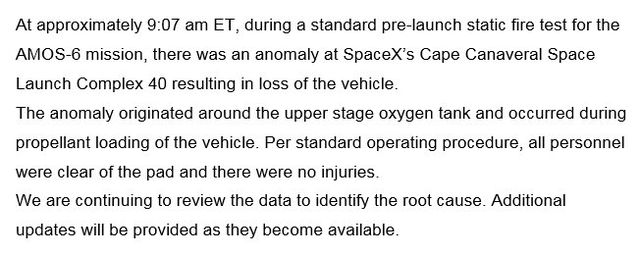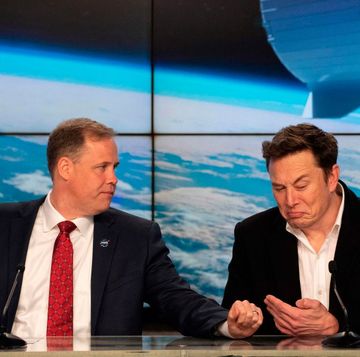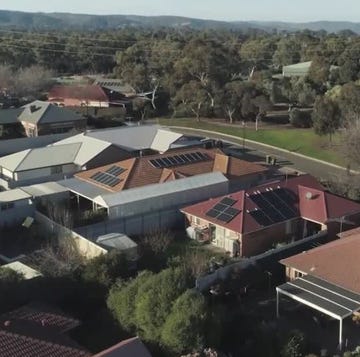Update, 1:32 PM: SpaceX has issued this statement about the explosion:
This early explanation places the initial trouble near the upper stage oxygen tank as the rocket was being loaded with propellant. Presumably the oxygen and fuel mixed. Successful launches are controlled, directed explosions. Catastrophes occur when the two mix when you don't want them to.
This morning, a SpaceX rocket exploded on the launchpad at Cape Canaveral in Florida. The $195 million satellite payload was reportedly lost in the disaster. We don't know much yet about how or why this happened, but here's what you need to know as the investigation unfolds.
1) Launchpads Are More Complicated—and Dangerous—Than You Think
You need more than a slab of concrete to launch a rocket that can deposit a satellite into orbit. A visit to a launchpad reveals a lot of engineering. There are fuel and oxidizer lines carved through thick structures of steel-reinforced concrete, networks of electrical lines stretching between the pad and control centers, scores of sensors that need to be online, lightning towers, and massive tanks of pressurized gasses. People are kept at a distance, inside hardened bunkers.
SpaceX does all this a little differently than everybody else. Unlike other launchers, SpaceX assembles its rockets horizontally. That means there are no massive launch towers or vertical assembly buildings here like the ones that mark the skyline in other parts of Cape Canaveral. Rockets travel on a rail line down to the transporter-erector vehicle. The machine slides out from a preparation facility, holds the rocket horizontally, and then maneuvers it upright on the launchpad. That feature is supposed to make the company recover more quickly from scrubs and delays. It's also safer for the rocket and payload, which can rest indoors until the run-up to the launch.
Unfortunately, that didn't save SpaceX today. A static test fire like this morning's is a dress rehearsal for the real thing, and the rocket was on the pad when the "destructive anomaly" occurred. The damage is unknown, but the entire pad has not been destroyed—video of the launchpad shows that the 110,000 ton spherical tank of liquid oxygen is still there, for example.
2) This Was To Be a Routine Test, But an Important One
Any rocket launch is a series of countdowns and checklists. One of these engineering rituals is the static fire test, which is designed to test the launchpad as much as it is to test the rocket. Fuel is loaded, lines are purged, cascades of water that dampen sound and vibration are opened. Engineers then pore over the results of the static fire to make sure the launch will be a success.
Static fires are not high-risk operations, typically. The engines are lit only for a few seconds, during the culmination of a static fire test. What's risky about them is that during the test, the valuable rocket has an even-more-holy payload on board, and SpaceX now says it lost the nearly $200 million satellite payload during today's accident.
3) Are SpaceX's New Upgrades to Blame?
In December, SpaceX upgraded the Falcon 9 rocket to use even colder liquid oxygen. (The rocket uses kerosene fuel and liquid oxygen as an oxidizer.) The colder temperatures were meant to decrease the amount of liquid oxygen lost as it heats and boils off. This extra LOx would be used for cooling stuff like landing rocket stages for later reuse.
Elon Musk wrote of the upgrades on twitter. "Deep cryo increases density and amplifies rocket performance. First time anyone has gone this low for O2."
But keeping LOx supercooled (-340 F or so) is not easy. "The new supercool liquid oxygen proved to be a challenge during static firing tests," wrote Jason Davis in the Planetary Society blog.
Changes in the rocket have to be high on the list of possible culprits, because changes in the rocket necessarily influence procedures on the pad. So did the new LOx scheme contribute to this morning's catastrophe? Anything new will be scrutinized, but this is a damned if you did, damned if you didn't kind of calculus. If the recent changes introduced a problem that was behind today's disaster, then it can be corrected quickly. The downside is that it makes further revisions, changes and upgrades more risky—at least in the eyes of launch customers who don't want to lose their pricey payloads.
Rocket companies like SpaceX sell their services based on confidence in the launch company, and will trade money for reliability. That is why Arianespace and United Launch Alliance can charge so damn much.
Here's the other side of the coin: If it turns out that some unchanged system failed or there was some human error, it could make SpaceX appear guilty of sloppy operations instead of being overzealous in seeking optimization. And that is a worse crime.
4) This One Is Weird Because It Didn't Happen During a Launch
What's especially odd about this disaster is that the SpaceX statement says the "anomaly" occurred during preparation for the static test, not even the test itself. Most marquee losses of rockets happen during a full launch. Of these, very few happen on launch pads. Even SpaceX's other mishaps have happened as the rocket is in flight, which is obviously considered the riskiest part of the launch due to its speed and violence.
Orbital Sciences CRS Flight 3 exploded on the pad at Wallops Island, Virginia, in 2014, but that mishap occurred about three seconds into the actual launch. Investigators found a turbopump in the engine malfunctioned, leading to the rocket's destruction. The launchpad is repaired, but has not yet launched anything. The worst launchpad disaster is the 2003 Alcântara VLS accident in Brazil. The national space agency rocket's engine ignited accidentally. The subsequent explosion killed 21 people working on the pad.
This morning the Brevard County Emergency Operations Center tweeted:
It's a somber reminder that these things can always be worse.
Joe Pappalardo is a contributing writer at Popular Mechanics and author of the new book, Spaceport Earth: The Reinvention of Spaceflight.














